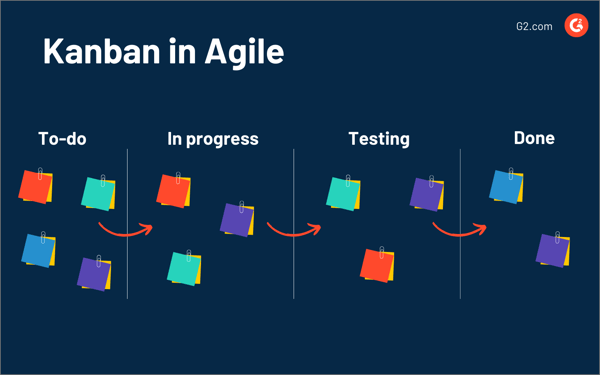February 8, 2024
 by Sandeep Kashyap / February 8, 2024
by Sandeep Kashyap / February 8, 2024

A major ordeal with unfinished tasks is the overall delay in completion and the loss of accuracy and precision.
With teams embracing Agile frameworks, this issue continuously grows. The higher the number of tasks your employees are working on simultaneously, the higher the chances for committing errors and exponential delays.
Kanban in Agile project management addresses these efficiencies. It focuses on reducing the time required to complete a task, with continual improvement in every iteration.
In this post, we will discuss the ways Kanban in Agile project management works and how it solves the problem of incomplete assignments.
Kanban focuses on producing products based on real-time consumer demand rather than the anticipated demand. This results in an improved match of the supply and the demand; preventing overstocking or undersupply of products. It is also known as just-in-time (JIT) manufacturing.
Originally, Kanban came into existence as the project management methodology in the manufacturing industry (by Taiichi Ohno, a Toyota engineer from Japan, in the late 1940s).
The approach is based on the philosophy of continuous improvement. It improves the workflow by spotting the bottlenecks on the visual Kanban board and resolving them immediately.
The same Kanban values are applied in Agile software development, where the development team pulls the work from the backlog based on its capacity and tries to eliminate the bottlenecks as soon as it is spotted. It is achieved through work in progress (WIP) limits, which we will discuss later in detail.
The purpose is to commit to the right amount of work and get it done as fast as possible. Many project management tools support both methodologies.

An Agile framework is built when teams imbibe flexibility and adaptability into their workflow. With increased flexibility, Agile teams are able to fulfill the expectations of the end user with ease.
When working in an Agile framework, there are a number of challenges that crop up. This includes a lack of skilled resources, frequent changes, no mathematical quantity to measure quality, and, in some cases, inadequate information.
To overcome such challenges and to streamline the workflow, Kanban boards are used. These boards ensure the smooth progression of the tasks as well as emphasize a limit on the flexible approach.
When you are incorporating Kanban project management in an Agile framework, there are key practices you must follow. This is essential for building a strong foundation to develop the Agile framework.
In order to build a workflow, you need to understand the workflow. This will help you to differentiate tasks into different stages. By differentiating work progression into different stages, you can identify spots where you are facing issues.
When you are aware of the different stages, you will be able to better define your resource allocation. This would also help you in forecasting and planning future task activities.
Multitasking gets the work done quickly. This is a psychological myth. The issue with managing multiple tasks is that the probability of making mistakes also goes up significantly.
On the Kanban board, you can define the WIP limit. With WIP limits the number of tasks in every stage is limited. This means employees finish the existing task before moving to the next one.
The Kanban board provides you with a quick visualization of the stage with major roadblocks. When you identify a particular stage where tasks are accumulated, you can bring in more resources to ensure smooth progression.
By rearranging your resources, you are able to eliminate roadblocks and ensure smooth progression. This will help you in effective deadline management and accommodating the required flexibility.
Kanban boards display the workflow of the entire team transparently.
Every team member is aware of what their peer is up to. This eliminates confusion and encourages team collaboration. Your team members can identify tasks with short deadlines and complete them accordingly.
Documentation is another key factor in Kanban project management. This will serve as a role model when it comes to managing roles, responsibilities, workflows, and protocols. Proper documentation also eliminates confusion and helps team members work with confidence.
Feedback sessions are like cornerstones. This is the basic structure that ensures efficient flexibility and adaptability in the Agile framework. The continuous feedback mechanism gives you time to incorporate changes, modifications, and alterations as needed.
Additionally, effective collaboration and feedback communication help in identifying growth opportunities for incremental growth. By understanding the typical requirements of the end user, you can focus on providing true value to them.
Continuous improvement is possible when your team works together. This helps in identifying potential problems as well as opportunities for growth. When team members can work in tandem, the overall productivity of the company increases.
With a transparent understanding of the workflow, all your team members will be on the same page. They will be able to solve issues at the local level and also ensure effective deadline management.
When it comes to an Agile framework you can choose between multiple project management methodologies. The different methodologies depend on the basis you wish to manage your projects and teams.
Kanban, Scrum, Lean, and Extreme Programming are some of the most famous methodologies for managing projects in an Agile framework. However, Lean and Extreme Programming have their typical applications.
Kanban and Scrum hold a very close relationship. However, the choice between these two methodologies depends on the project requirements.
Kanban project management has tasks that are differentiated in the form of stages. While in Scrum, the different stages are completed in the form of short cycles.
The key factors that differentiate these two methodologies are:
1. When your tasks are divided into chunks, Scrum methodology works best.
This is where your Scrum team can pull up a task from the backlog and finish it in a single sprint. Each Sprint has a maximum duration of four weeks.
However, in cases where tasks are not divided into different chunks and are repetitive and continuous, Kanban is the methodology suited for you.
This is where you divide the task flow into different stages. Team members complete the tasks in a particular stage and move ahead to the next stage. In this way, the tasks move from one stage to another, eventually till the conclusion.
2. The key difference between Kanban and Scrum is the way roles are defined.
Kanban project management is a continuous process where the entire team owns the Kanban board. They work together in collaboration to ensure the smooth progression of the tasks across different stages.
However, in Scrum, different roles are defined with rigidity. There is a Scrum master who oversees the entire process. The Scrum team members, product owners, and stakeholders have a defined set of responsibilities.
Further, reviews and meetings are planned and executed accordingly.
Kanban project management helps streamline workflow in an Agile framework. With Kanban boards that provide a visualization of task flow, Agile teams can identify potential causes of delay. This provides flexibility and the space to adapt to sudden changes in the environment.
The following pointers will provide you with the basic usability functions of Kanban project management methodology in your Agile framework.
Kanban comes in handy when you want to manage repetitive requests at the same time.
This could be in the form of support tickets or orders in a store. Kanban was originally introduced in the manufacturing line to ensure that production lines run smoothly. This makes Kanban project management capable of managing customer support.
Consider the example of a “customer helpdesk.”
The incoming tickets show up in the “to-do” stage. Once the team starts working on the ticket, the stage shifts to “in progress.” Once the ticket is resolved, it moves to the “done” stage.
In Kanban, tasks move through stages smoothly, getting completed step by step.
Every work item is independent of itself. Further, Kanban project management does not have the innate ability to track dependency.
Consider the example of a “sales call.”
In case a particular call is facing an exponential delay, then that ticket can be put on hold. You can mark the ticket on the board and move on to the next call. This will prevent your team members from wasting time. They can get back to that ticket as and when required.
Kanban provides you with sufficient flexibility to adapt to changes.
This plays a key role when the incoming requests vary widely. You do not have to change the defined workflow.
Consider the example of an Agile team planning their task activities and workflow on a Gantt chart.
The workflow is based on the task dependencies and a defined work order. This would use up a lot of productive time in strategizing the workflow. However, with Kanban, the defined workload remains the same. There is a focus on prioritization to ensure a smooth progression even with variable work input.
Kanban provides you with a continuous workflow that helps you identify limitations.
By visualizing the workflow, Kanban helps in identifying bottlenecks or areas where work might get stuck or delayed.
Consider the example of a workflow where there is premium machinery in a particular stage.
In such a case, you can only optimize the other stages to match the actual output of that particular machinery. There is no point in utilizing your resources to increase the output when the tasks face a blockade at that stage.
The value of the Agile team lies in effective project completion.
of the teams value on-time delivery as their success, whereas about 44% of the teams emphasized achieving business objectives successfully.
Source: info.digital.ai
Kanban project management helps Agile teams keep their progression on track and optimize the workflow. Every team member is aware of the exact progression of tasks and can identify potential issues with ease.
This helps the overall team to fulfill all expectations that come up on them.
To incorporate Kanban project management in your Agile workflow, follow this 4-step action plan based on its core principles. The key criterion to be noticed here is that you should take a slow and calculative approach.
Identify resources and processes where there is reasonable room for improvement.
Kanban project management does not enforce sudden and drastic changes in the workflow. You need to identify specific issues that are disrupting the workflow and work on optimizing the same.
Take one step at a time. Refrain from leaping ahead and making quick changes.
Sudden changes bring in overwhelming challenges and develop an environment of reluctance. This also discourages your employees from putting in their effort. This is because they have the fear of being faced with a new challenge suddenly.
Defining roles in Kanban within Agile teams means outlining who does what, while responsibilities detail the specific tasks and obligations tied to those roles.
It ensures clarity, alignment, and efficiency by making everyone's contributions clear and minimizing confusion, thereby enhancing overall team productivity.
From the CEO to the intern, encourage employees to be accountable for their tasks. When you develop accountability among your team members, they are motivated to put in their effort.
There is a boost to innovation and the flow of new ideas. By building an even platform for working, you encourage every employee to be participative.
“Kanban is a change-management technique that requires making alterations to an existing process: changes such as adding work-in-progress limits to it.”
David J. Anderson
Author of Kanban
This wise saying depicts the importance of WIP in our day-to-day work life.
In this section, you will see successful examples of renowned companies that used Kanban workflow to enhance agility and become customer-oriented.
Jaguar Land Rover, an automotive giant, faced cost overruns because of production delays in 2014. The feedback on designs took 12 weeks, causing significant delays and financial losses.
Recognizing the extra cost and need for change, project manager Hamish McMinn initiated a pilot project to revamp their workflow. They implemented a streamlined process focusing on minimum viable products, reducing team size and design batch sizes. This decreased the feedback loop from 12 weeks to just a few days.
The shift allowed stakeholders and management to see only what was necessary, promoting transparency and efficiency in the workflow. The quality of the projects went up by 30%.
Later, these changes were implemented all across the production floor.
Jaguar Land Rover has become a seasoned player when it comes to Kanban project management in the Agile framework. They now provide training to other people around the world.
This case study would dispel the widely acclaimed misconception that Kanban project management in the Agile framework is used in IT or manufacturing industries alone.
Pixar is one of the leading companies when it comes to the production of animated movies. The experience they offer arises from the contribution of several artists who work meticulously on the details. However, this collaborative endeavor raises a question: how do they efficiently assign scenes among these artists to prevent overlaps and ensure engaging animation quality?
Pixar introduced the Andon system in their studios to overcome these production challenges. This system had two key functionalities:
First, it made the process transparent. Team members had clarity of what their colleagues were up to. Second, this system empowered every member of the team to halt production if there were obstacles or bottlenecks in the process.
The Kanban board helps in implementing the Andon system. Team members have wide transparent visibility. They can identify potential bottlenecks and take necessary steps accordingly.
Zara is one of the most widespread fashion brands at the moment. While most brands limit themselves to three to four season trends in a calendar year, Zara sets the bar quite too high.
However, rearranging its entire shelf in 2 weeks across the globe comes with challenges. The issue revolves around maintaining consistency among widespread outlets and production facilities. It requires efficiently allocating tasks and maintaining visibility across teams.
Now this brings us to the practical application of Kanban-styled Agile workflow in the fashion industry.
Zara uses the JIT approach, also called Lean production. They use a combination of multiple Kanban boards, both at the store level, the factories, and the headquarters. Together with in-depth data analysis and predictive forecasting, they can stock up on goods in stores accordingly.
This starts with the Kanban pull system.
This is where the store managers raise requests for new batches. The sales, data analysts, and commercial teams review regional trends and past purchases. They update the requirement on the Kanban board, which moves over to the factories.
The factories are already ready with unfinished clothing that they can complete and ship to the necessary store as required. With every new order, they add a new style, which reaches the shop floor within two weeks of raising the order request.
This continuous process of evolution, adaptability, and flexibility has been the key factor that has helped Zara fulfill the changing fashion trends of the masses.
Kanban project management in an Agile framework provides industries and workspaces with several advantages.
However, three critical issues crop up as common challenges in most Agile frameworks.
When introducing Kanban boards, you need to ensure that your team members understand the process and workflow on the Kanban board. Without this step, they may feel overwhelmed with changes. The lack of clarity results in chaos and inefficient performance.
This issue can be solved by defining the purpose and reason for implementing Kanban project management.
This will provide your team members with a clear vision of what to expect in the Kanban methodology. Further, they would require reassurance that this new methodology will in no case affect their job security.
A key issue faced by several companies is resistance to change.
This happens when team members are not motivated enough to accept change. They are stuck in a vicious cycle and do not want to come out of that circle. Such employees generally panic and always want to remain in their comfort zone.
This can be solved by assuring your team members with incremental changes only. The transition to Kanban project management is always a slow process. This will accustom your team members to the process efficiently.
You will have to provide your team members with a clear picture of the working and advantages of the Kanban methodology. This will serve as a motivation for them to accept the system and work on the same.
When working in the Kanban system, dealing with unplanned tasks or interruptions poses another challenge.
These interruptions can impact the flow of work, as team members are already engaged in the planned work. It generally leads to bottlenecks or delays in completing tasks.
A practical solution for this is allocating buffer time within the Kanban system in case of handling unforeseen or urgent tasks. By setting aside this buffer time, the team creates space to manage unexpected work without significantly affecting the ongoing tasks.
Kanban offers a smooth workflow by focusing on team accountability and reducing potential obstacles.
Applying Kanban in Agile isn't a one-size-fits-all solution.
Instead, its success depends on adapting its principles to fit each project's unique characteristics and workflow. By doing so, teams can maximize the benefits of Kanban within Agile, improving collaboration, efficiency, and overall project success.
Learn more about the Agile manifesto and the principles that were later developed to build on its key values.
Edited by Aisha West
Sandeep Kashyap, the visionary CEO of ProofHub, boasts over 25 years of IT industry experience. He's a recognized luminary known for innovation and agility. His contributions extend to project management insights and leadership, growth, and entrepreneurship. His practical expertise is evident in ProofHub's success. His articles feature in Thrive Global, News Break, and Medium, and he's received accolades like the America's Best Startup Employer award. His wisdom has graced Fast Company, sharing innovation and practicality behind his entrepreneurial triumph.
A successful recipe never deceives. Likewise, a successful project management methodology...
 by Grace Pinegar
by Grace Pinegar
In project management, two prominent (and popular) methodologies have emerged as contrasting...
 by Aditya Agrawal
by Aditya Agrawal
No one wants to work for an organization that is rigid or overly strict about policies.
 by Mara Calvello
by Mara Calvello
A successful recipe never deceives. Likewise, a successful project management methodology...
 by Grace Pinegar
by Grace Pinegar
In project management, two prominent (and popular) methodologies have emerged as contrasting...
 by Aditya Agrawal
by Aditya Agrawal


